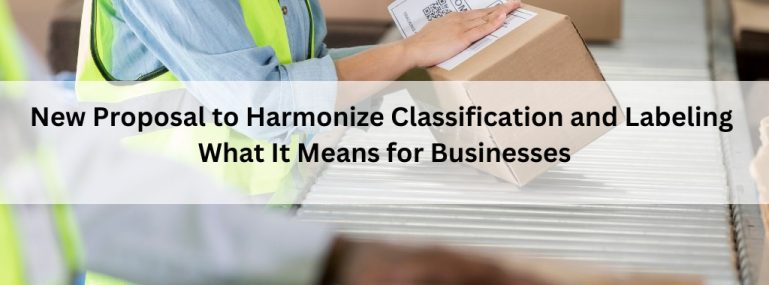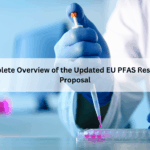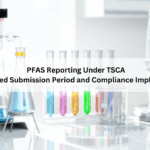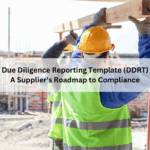The European Commission has introduced a new proposal aimed at harmonizing chemical classification and labeling across the EU. This initiative is part of the broader EU Chemicals Strategy for Sustainability, which seeks to improve both human health and environmental protection while also encouraging innovation within the chemical industry.
The proposal, which amends the existing Classification, Labeling, and Packaging (CLP) Regulation, brings substantial changes that will impact chemical manufacturers, importers, and downstream users. This blog explains what’s changing, why it matters, and how companies should prepare.
Why Harmonization Matters
Chemicals are used in nearly every industry—cosmetics, cleaning products, paints, plastics, electronics, and more. Although the EU already has strict CLP regulations, inconsistent classification and labeling practices can lead to:
- Confusion across the supply chain
- Increased compliance costs
- Potential risks to consumer safety and the environment
A harmonized approach ensures chemicals are assessed and labeled consistently across all EU member states, increasing transparency, supporting the single market, and better protecting public health.
Key Elements of the New Proposal
1. New Hazard Categories Introduced
The updated CLP Regulation proposes new hazard classes, including:
- Endocrine disruptors, which pose risks to human health and the environment
- Persistent, Bioaccumulative, and Toxic (PBT) substances
- Persistent, Mobile, and Toxic (PMT) substances
These additions reflect advancements in scientific understanding and increased concern about long-term and low-dose chemical exposure.
2. Broader Use of Harmonized Classifications
The proposal aims to expand the scope and frequency of harmonized classification decisions at the EU level. More substances will receive official classifications, reducing the need for inconsistent self-classifications by companies.
3. Stricter Self-Classification Rules
Companies will face stricter requirements when self-classifying substances, including stronger scientific justification and improved documentation—helping to increase accountability and data quality.
4. Digital Labeling Options
The new regulation includes provisions for digital labelling, allowing key product information, such as multilingual safety instructions, to be accessed via QR codes or links. This reduces packaging waste and improves accessibility for users.
5. Faster Updates and Streamlined Processes
The proposal seeks to accelerate the update process for classifications and labels in response to new scientific data, ensuring regulations remain timely and responsive to emerging risk
Business Implications
The proposed regulation could significantly affect how chemicals are assessed, labelled, and marketed in the EU. Key impacts for businesses include:
- Greater compliance responsibility: Companies must regularly monitor regulatory changes and align with EU-wide classifications.
- Reformulation and relabeling: Products with substances newly classified under the updated hazard categories may require reformulation, relabeling, or in some cases, removal from the market.
- Increased data requirements: Manufacturers and importers may need to provide more comprehensive hazard data to support self-classification or maintain current classifications.
- Supply chain disruption: Classification changes could impact sourcing, production, marketing, and end-user safety throughout the supply chain.
How Businesses Can Prepare
1.Review Your Product Portfolio
Assess whether your substances or mixtures fall under the new hazard categories.
2.Communicate with Suppliers
Ensure upstream partners are aware of the changes and are reviewing their chemical inventories.
3.Upgrade Compliance Systems
Update internal systems for classification, labeling, and chemical safety reporting.
4.Train Key Teams
Regulatory, R&D, and marketing teams should understand the updated CLP rules and their implications.
5.Stay Informed
Track developments from ECHA and the EU Commission, including guidance documents, deadlines, and stakeholder consultations.
The EU’s proposal to harmonize classification and labeling is a forward-thinking move toward a safer, more sustainable chemical industry. While it introduces new compliance challenges, it also offers greater clarity, consistency, and a foundation for innovation and consumer trust.
Businesses that act proactively will not only ensure compliance but also gain a competitive edge in a marketplace where safety and sustainability are growing priorities.
FAQs:
1. What is the goal of the proposed classification and labeling framework?
The proposal aims to align the classification and labeling of hazardous substances across the EU. It seeks to reduce inconsistencies, enhance consumer protection, and simplify compliance by ensuring chemicals are properly identified and hazards are communicated effectively.
2. Why is harmonization important?
Currently, some substances are classified differently by various companies, creating confusion and potential safety risks. Harmonization promotes consistent, science-based classifications, minimizing discrepancies and providing better protection for workers and consumers.





